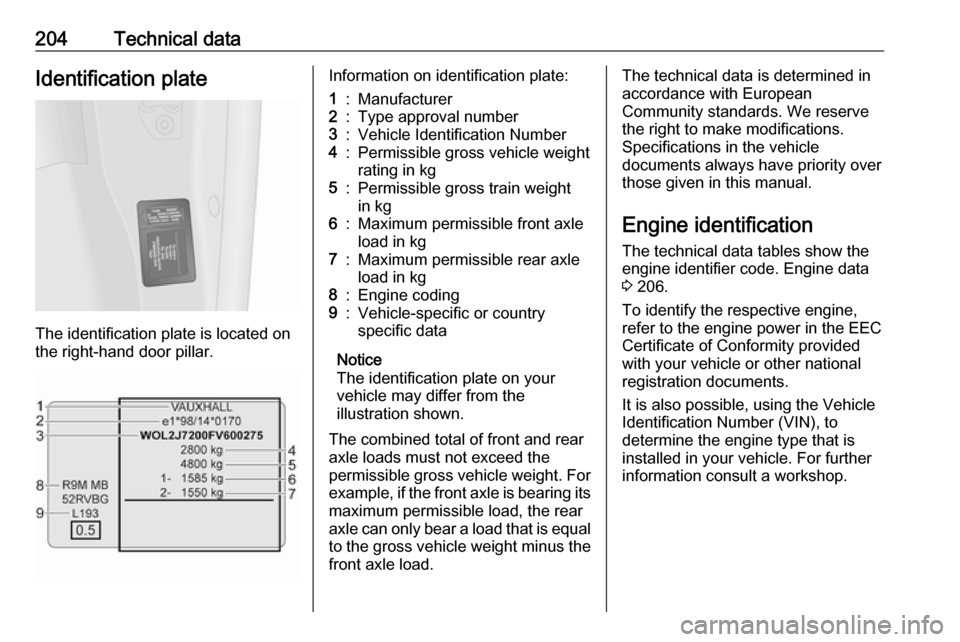VAUXHALL VIVARO 2017.5 Owner's Manual
Manufacturer: VAUXHALL, Model Year: 2017.5, Model line: VIVARO, Model: VAUXHALL VIVARO 2017.5Pages: 231, PDF Size: 5.52 MB
Page 201 of 231

Vehicle care199Paintwork damageRectify minor paintwork damage witha touch-up pen before rust forms.
Have more extensive damage or rust areas repaired by a workshop.
Underbody
Some areas of the vehicle underbody
have a PVC undercoating while other critical areas have a durable
protective wax coating.
After the underbody is washed, check
the underbody and have it waxed if
necessary.
Bitumen/rubber materials could
damage the PVC coating. Have
underbody work carried out by a
workshop.
Before and after winter, wash the
underbody and have the protective
wax coating checked.
Towing equipment
Do not clean the coupling ball bar with a steam-jet or high-pressure jet
cleaner.Interior care
Interior and upholstery Only clean the vehicle interior,
including the instrument panel fascia
and panelling, with a dry cloth or
interior cleaner.
Clean any leather upholstery with
clear water and a soft cloth. In case of
heavy soiling, use leather care.
The instrument cluster and the
displays should only be cleaned using
a soft damp cloth. If necessary use a
weak soap solution.
Clean fabric upholstery with a
vacuum cleaner and brush. Remove
stains with an upholstery cleaner.
Clothing fabrics may not be
colourfast. This could cause visible
discolourations, especially on light-
coloured upholstery. Removable
stains and discolourations should be
cleaned as soon as possible.
Clean seat belts with lukewarm water or interior cleaner.Caution
Close Velcro fasteners as open
Velcro fasteners on clothing could damage seat upholstery.
The same applies to clothing with
sharp-edged objects, like zips or
belts or studded jeans.
Plastic and rubber parts
Plastic and rubber parts can be
cleaned with the same cleaner as
used to clean the body. Use interior cleaner if necessary. Do not use any
other agent. Avoid solvents and petrol in particular. Do not use high-
pressure jet cleaners.
Page 202 of 231

200Service and maintenanceService and
maintenanceGeneral information ...................200
Service information ..................200
Recommended fluids, lubricants
and parts .................................... 201
Recommended fluids and lubricants ................................ 201General information
Service information In order to ensure economical and
safe vehicle operation and to
maintain the value of your vehicle, it
is of vital importance that all
maintenance work is carried out at the proper intervals as specified.
The detailed, up-to-date service
schedule for the vehicle is available at
the workshop.
Service display 3 91.
Engine identification 3 204.
European service intervals Maintenance of your vehicle is
required every 25,000 miles or after two years, whichever occurs first,unless otherwise indicated by the
service display.
A shorter service interval can be valid for severe driving behaviour, e.g. for
taxis and police vehicles.
The European service intervals are
valid for the following countries:Andorra, Austria, Belgium, Croatia,
Czech Republic, Denmark, Estonia,
Finland, France, Germany, Greece,
Hungary, Iceland, Ireland, Italy,
Latvia, Liechtenstein, Lithuania,
Luxembourg, Netherlands, Norway,
Poland, Portugal, Slovakia, Slovenia,
Spain, Sweden, Switzerland, United
Kingdom.
Service display 3 91.
Confirmations
Confirmation of service is recorded in the Service and warranty booklet.
The date and mileage is completed
with the stamp and signature of the servicing workshop.
Make sure that the Service and
warranty booklet is completed
correctly as continuous proof of
service is essential if any warranty or goodwill claims are to be met, and is
also a benefit when selling the
vehicle.
Service display The service interval is based on
several parameters depending on
usage.
Page 203 of 231

Service and maintenance201The service display, located in the
Driver Information Centre, indicates
when the next service is due. Seek
the assistance of a workshop.
Service display 3 91.Recommended fluids,
lubricants and parts
Recommended fluids andlubricants
Only use products that meet the
recommended specifications.9 Warning
Operating materials are
hazardous and could be
poisonous. Handle with care. Pay
attention to information given on
the containers.
Engine oil
Engine oil is identified by its quality
and its viscosity. Quality is more
important than viscosity when
selecting which engine oil to use. The oil quality ensures e.g. engine
cleanliness, wear protection and oil
aging control, whereas viscosity
grade gives information on the oil's
thickness over a temperature range.
Dexos is the newest engine oil quality
that provides optimum protection for diesel engines. If it is unavailable,
engine oils of other listed qualities
must be used.
Select the appropriate engine oil based on its quality and on the
minimum ambient temperature
3 205.
Topping up engine oil
Engine oils of different manufacturers
and brands can be mixed as long as
they comply with the required engine
oil quality and viscosity.
Use of engine oil with only
ACEA A1/B1 or only A5/B5 quality is
prohibited, since it can cause long-
term engine damage under certain
operating conditions.
Select the appropriate engine oil
based on its quality and on the
minimum ambient temperature
3 205.
Additional engine oil additives
The use of additional engine oil
additives could cause damage and
invalidate the warranty.
Page 204 of 231

202Service and maintenanceEngine oil viscosity grades
The SAE viscosity grade gives
information of the thickness of the oil.
Multigrade oil is indicated by two
figures, e.g. SAE 5W-30. The first
figure, followed by a W, indicates the
low temperature viscosity and the
second figure the high temperature viscosity.
Select the appropriate viscosity grade
depending on the minimum ambient
temperature 3 205.
All of the recommended viscosity
grades are suitable for high ambient
temperatures.
Coolant and antifreeze
Use only silicate-free long life coolant (LLC) antifreeze approved for the
vehicle. Consult a workshop.
The system is factory filled with
coolant designed for excellent
corrosion protection and frost
protection down to approx. -28 °C.
This concentration should be
maintained all year round. The use of additional coolant additives that
intend to give additional corrosionprotection or seal against minor leaks
can cause function problems. Liability
for consequences resulting from the
use of additional coolant additives will be rejected.
Washer fluid Use only washer fluid approved for
the vehicle to prevent damage of
wiper blades, paintwork, plastic and
rubber parts. Consult a workshop.
Brake fluid Over time, brake fluid absorbs
moisture which will reduce braking
effectiveness. The brake fluid should
therefore be replaced at the specified
interval.
AdBlue Only use AdBlue to reduce the
nitrogen oxides in the exhaust
emission 3 137.
Page 205 of 231

Technical data203Technical dataVehicle identification..................203
Vehicle Identification Number ..203
Identification plate ...................204
Engine identification ................204
Vehicle data ............................... 205
Recommended fluids and lubricants ................................ 205
Engine data ............................. 206
Vehicle weight ......................... 208
Vehicle dimensions .................210
Capacities ................................ 215
Tyre pressures ........................ 216Vehicle identification
Vehicle IdentificationNumber
The Vehicle Identification Number is
visible through the windscreen.
The VIN is also displayed behind a
removable plastic cover on the right-
hand side door step.
Page 206 of 231

204Technical dataIdentification plate
The identification plate is located on
the right-hand door pillar.
Information on identification plate:1:Manufacturer2:Type approval number3:Vehicle Identification Number4:Permissible gross vehicle weight
rating in kg5:Permissible gross train weight
in kg6:Maximum permissible front axle
load in kg7:Maximum permissible rear axle
load in kg8:Engine coding9:Vehicle-specific or country
specific data
Notice
The identification plate on your
vehicle may differ from the
illustration shown.
The combined total of front and rear
axle loads must not exceed the
permissible gross vehicle weight. For
example, if the front axle is bearing its
maximum permissible load, the rear
axle can only bear a load that is equal
to the gross vehicle weight minus the front axle load.
The technical data is determined in
accordance with European
Community standards. We reserve
the right to make modifications.
Specifications in the vehicle
documents always have priority over
those given in this manual.
Engine identification
The technical data tables show the
engine identifier code. Engine data
3 206.
To identify the respective engine,
refer to the engine power in the EEC
Certificate of Conformity provided
with your vehicle or other national
registration documents.
It is also possible, using the Vehicle
Identification Number (VIN), to
determine the engine type that is
installed in your vehicle. For further
information consult a workshop.
Page 207 of 231

Technical data205Vehicle data
Recommended fluids and lubricants
Required engine oil qualityEngine oil quality: Europedexos 2✔
For countries with International
service interval 3 200, you may use
the oil qualities listed below:
Engine oil quality: Internationaldexos 2✔GM-LL-A/B-025✔ACEA C3
diesel engines with DPF✔ACEA A3/B4
diesel engines without DPF✔Engine oil viscosity gradesAmbient temperaturedown to -25 °CSAE 5W-30 or
SAE 5W-40below -25 °CSAE 0W-30 or
SAE 0W-40
Page 208 of 231

206Technical dataEngine data
Sales designation
1.6 BITurbo
120 1)1.6 CDTI 90,
1.6 CDTI 90
ecoFLEX 2)1.6 CDTI
115 2)1.6 BITurbo 120
ecoFLEX 2)1.6 BITurbo 140,
1.6 BITurbo 140
ecoFLEX 2)Engine identifier codeR9M 450 (MC)R9M 408 (ME)R9M 408
(MD)R9M 450 (MB)R9M 450 (MA)Number of cylinders44444Piston displacement
[cm 3
]15981598159815981598Engine power [kW]88668588103at rpm35003500350035003500Torque [Nm]320260300285340at rpm15001500175015001750Fuel typeDieselDieselDieselDieselDiesel1) Euro 4.
2) Euro 5.
Page 209 of 231

Technical data207
Sales designation
1.6 CDTI 95,
1.6 CDTI 95 ecoFLEX 3)1.6 CDTI 1203)1.6 BITurbo 125
ecoFLEX 3)1.6 BITurbo 145
ecoFLEX 3)Engine identifier codeR9M 413 (MJ)R9M 413 (MK)R9M 452 (MH)R9M 452 (MG)Number of cylinders4444Piston displacement [cm 3
]1598159815981598Engine power [kW]708992107at rpm3500350035003500Torque [Nm]260300320340at rpm1500175015001750Fuel typeDieselDieselDieselDiesel3) Euro 6 with AdBlue.
AdBlue 3 137.
Page 210 of 231

208Technical dataVehicle weight
Kerb weight, basic model Optional equipment and accessories increase the kerb weight.
Loading information 3 80.ModelEngineWheelbaseRoofPayload Class
Gross Vehicle Weight rating
[kg]Kerb weight 4)5)
[kg]VanR9ML1H1100027001661120029001661H2120029001760-1771L2H1120029001691-1695H21200290017754) Kerb weight and gross vehicle weight increase on models fitted with bad road equipment package - refer to identification plate on the
right-hand door pillar.
5) Minimum vehicle weight according to Type Approval, including all fluids, vehicle tools and a 90% fuel load. Excludes the weight of
the driver and deletable options, e.g. spare wheel, bulkhead and sliding side load door. Final weight may vary according to the
specification of the vehicle, e.g. options, deleted options and accessories.